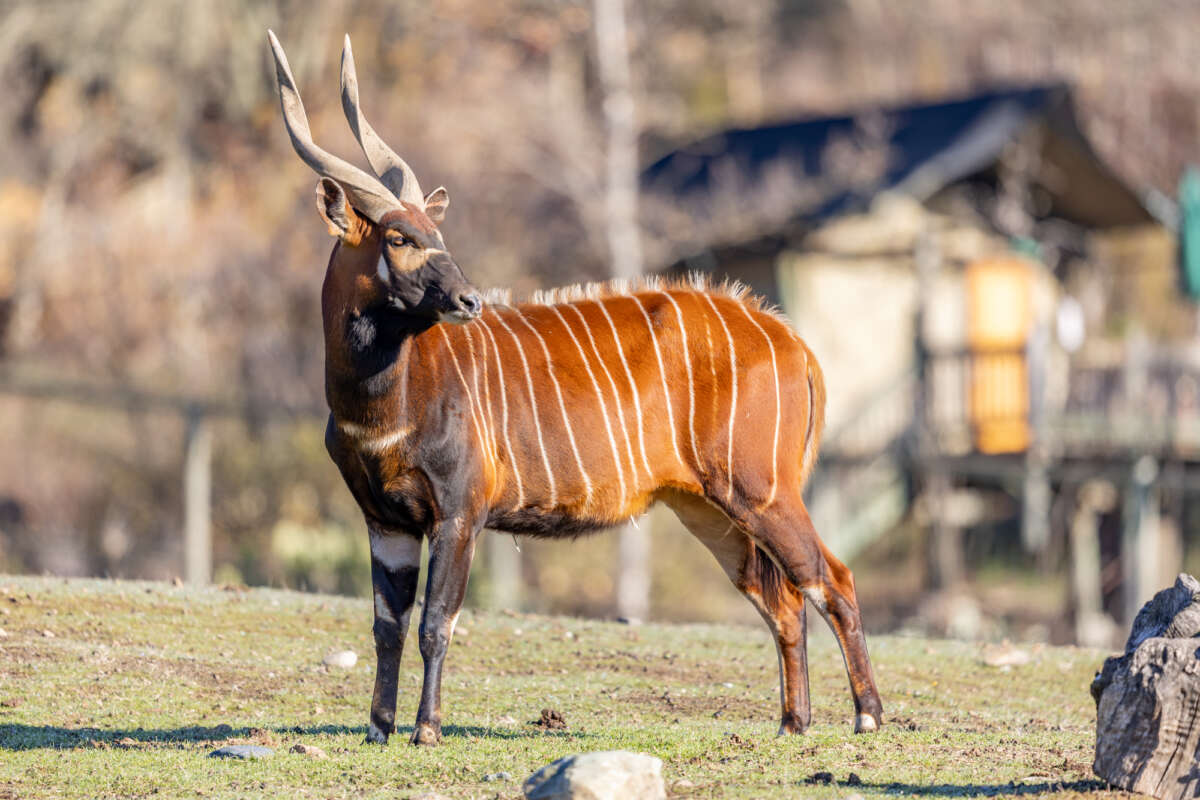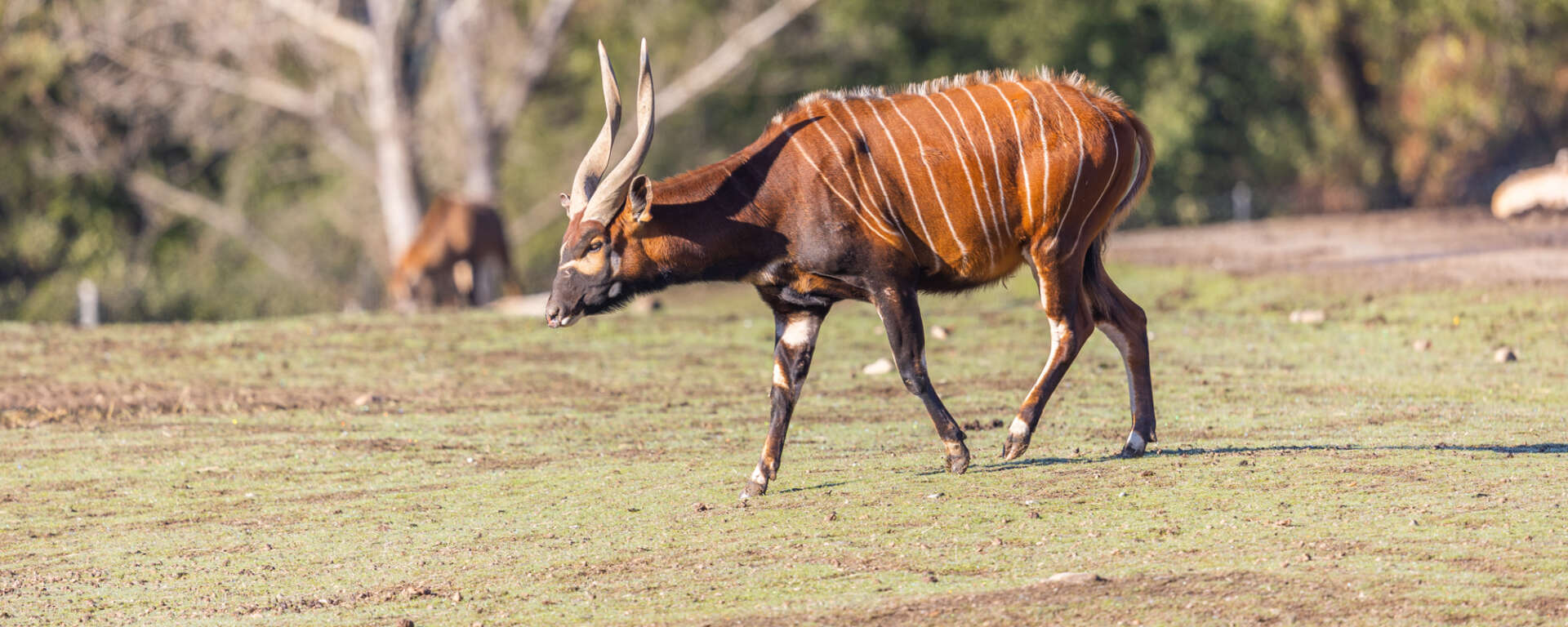Description
Bongos are the largest and, with their rich, red coat, the most colorful of the African forest antelopes. Females and young are chestnut red while the males darken with age, eventually becoming a dark brown-black. Males and females alike have 10 – 15 white vertical stripes on their bodies. These stripes are a form of disruptive camouflage—as the bongo walks through vertical sunbeams that pierce its rainforest habitat, the stripes may help to break apart the bongo’s body shape in the eyes of a potential predator, and disrupt that predator’s mental blueprint of the prey it is after. Both sexes also have long spiraling horns 30 – 40 in (75 – 100 cm) long, with those of the female thinner and more parallel.
Cover photo: Adult male bongo by Mark Pressler
Classification
- Overview
- The bongo is an antelope in the Tragelaphini tribe, which are known as the spiral-horned antelope. Other members of this tribe include the eland, kudu, and nyala.
- Class
- Mammalia
- Order
- Cetartiodactyla
- Family
- Bovidae
- Tribe
- Tragelaphini
- Genus
- Tragelaphus
- Species
- T. eurycerus
Key Facts
- Conservation Status
- Near Threatened; Mountain subspecies Critically Endangered
- Lifespan
- ~10 years in the wild, ~22 years under human care
- Height (at shoulder)
- 3.5 – 4.3 ft (~110 – 130 cm)
- Weight
- 525 – 880 lbs (~240 – 400 kg)
The IUCN Red List describes the bongo as Near Threatened. This means that as a whole, populations are not quite threatened with risk of extinction, but should be watched closely. There are two subspecies of bongo: the western, or lowland bongo and the eastern, or mountain bongo. Populations of both subspecies are declining due to loss of habitat and pressure from hunting. The IUCN currently estimates that there are somewhere between 15,000 – 25,000 mature bongos in the wild, most of which are western bongos.
Surveys in 1999 estimated that there were around 28,000 western bongos, but the bongo’s deep rainforest habitat, large areas of movement, and dawn/dusk/nighttime activity patterns make it extremely difficult to make reliable population estimates.
The eastern (mountain) bongo is Critically Endangered with an estimated 100 individuals remaining in the wild, limited to a few highland forests in Kenya. A large collaboration is underway between the Meru County government in Kenya, the Kamulu and Ntimaka Community Forest Associations, Kenya Wildlife Service, Kenya Forest Service, Lewa Wildlife Conservancy, and other conservation agencies, resulting in the creation of the Meru Bongo & Rhino Conservation Trust. This new organization’s goal is to manage the land that the remaining mountain bongos live on, and create a breeding sanctuary for mountain bongos. Once this new sanctuary is in place, the trust plans on working with the Rare Species Conservatory Foundation in Florida to move a herd of mountain bongos from Florida to Kenya. Construction of the new sanctuary started in February 2023.
Social Life
Bongo are the only forest antelope to form herds which can range from 5 – 10 all the way up to 50 individuals. The males tend to be solitary, while females and their young comprise most of the herd. Bongo are very shy and disappear quickly into the forest. When running they hold their horns against the back of their neck to avoid tangling them in the surrounding vegetation. They are most active between dusk and dawn. Because of their elusive behavior and habitat, bongo have been difficult to study and little is known about the activities of these reclusive creatures.
Habitat and Range
Bongo are found in dense tropical jungles with thick undergrowth in Central and West Africa. Two subspecies of bongo exist: the western (lowland) bongo, T. e. eurycerus, are found in the lowland forests of West Africa and Zaire to southern Sudan; and the eastern (mountain) bongo, T. e. isaaci which are isolated to highlands in Kenya.
Diet
Bongo are browsers and grazers eating leaves, flowers, twigs, shrubs, vines, thistles, and grasses. They use their long tongue to reach leaves and their horns to pull down high branches and vines. They are known to visit natural salt licks regularly.
Predators
The primary predator of the bongo is the leopard.
Reproduction
Sexual maturity: Male: 3 years, Female: 2.5 years
Mating Season: Unknown in the wild, opportunistic under human care
Birth Season: Unknown
Gestation: 9 months
No. of Young: 1
- Information
-
Description
Bongos are the largest and, with their rich, red coat, the most colorful of the African forest antelopes. Females and young are chestnut red while the males darken with age, eventually becoming a dark brown-black. Males and females alike have 10 – 15 white vertical stripes on their bodies. These stripes are a form of disruptive camouflage—as the bongo walks through vertical sunbeams that pierce its rainforest habitat, the stripes may help to break apart the bongo’s body shape in the eyes of a potential predator, and disrupt that predator’s mental blueprint of the prey it is after. Both sexes also have long spiraling horns 30 – 40 in (75 – 100 cm) long, with those of the female thinner and more parallel.
Cover photo: Adult male bongo by Mark Pressler
Classification
- Overview
- The bongo is an antelope in the Tragelaphini tribe, which are known as the spiral-horned antelope. Other members of this tribe include the eland, kudu, and nyala.
- Class
- Mammalia
- Order
- Cetartiodactyla
- Family
- Bovidae
- Tribe
- Tragelaphini
- Genus
- Tragelaphus
- Species
- T. eurycerus
Key Facts
- Conservation Status
- Near Threatened; Mountain subspecies Critically Endangered
- Lifespan
- ~10 years in the wild, ~22 years under human care
- Height (at shoulder)
- 3.5 – 4.3 ft (~110 – 130 cm)
- Weight
- 525 – 880 lbs (~240 – 400 kg)
- Conservation
The IUCN Red List describes the bongo as Near Threatened. This means that as a whole, populations are not quite threatened with risk of extinction, but should be watched closely. There are two subspecies of bongo: the western, or lowland bongo and the eastern, or mountain bongo. Populations of both subspecies are declining due to loss of habitat and pressure from hunting. The IUCN currently estimates that there are somewhere between 15,000 – 25,000 mature bongos in the wild, most of which are western bongos.
Surveys in 1999 estimated that there were around 28,000 western bongos, but the bongo’s deep rainforest habitat, large areas of movement, and dawn/dusk/nighttime activity patterns make it extremely difficult to make reliable population estimates.
The eastern (mountain) bongo is Critically Endangered with an estimated 100 individuals remaining in the wild, limited to a few highland forests in Kenya. A large collaboration is underway between the Meru County government in Kenya, the Kamulu and Ntimaka Community Forest Associations, Kenya Wildlife Service, Kenya Forest Service, Lewa Wildlife Conservancy, and other conservation agencies, resulting in the creation of the Meru Bongo & Rhino Conservation Trust. This new organization’s goal is to manage the land that the remaining mountain bongos live on, and create a breeding sanctuary for mountain bongos. Once this new sanctuary is in place, the trust plans on working with the Rare Species Conservatory Foundation in Florida to move a herd of mountain bongos from Florida to Kenya. Construction of the new sanctuary started in February 2023.
- Lifestyle
Social Life
Bongo are the only forest antelope to form herds which can range from 5 – 10 all the way up to 50 individuals. The males tend to be solitary, while females and their young comprise most of the herd. Bongo are very shy and disappear quickly into the forest. When running they hold their horns against the back of their neck to avoid tangling them in the surrounding vegetation. They are most active between dusk and dawn. Because of their elusive behavior and habitat, bongo have been difficult to study and little is known about the activities of these reclusive creatures.Habitat and Range
Bongo are found in dense tropical jungles with thick undergrowth in Central and West Africa. Two subspecies of bongo exist: the western (lowland) bongo, T. e. eurycerus, are found in the lowland forests of West Africa and Zaire to southern Sudan; and the eastern (mountain) bongo, T. e. isaaci which are isolated to highlands in Kenya.Diet
Bongo are browsers and grazers eating leaves, flowers, twigs, shrubs, vines, thistles, and grasses. They use their long tongue to reach leaves and their horns to pull down high branches and vines. They are known to visit natural salt licks regularly.Predators
The primary predator of the bongo is the leopard.Reproduction
Sexual maturity: Male: 3 years, Female: 2.5 years
Mating Season: Unknown in the wild, opportunistic under human care
Birth Season: Unknown
Gestation: 9 months
No. of Young: 1

Adult male bongo by Mark Pressler

